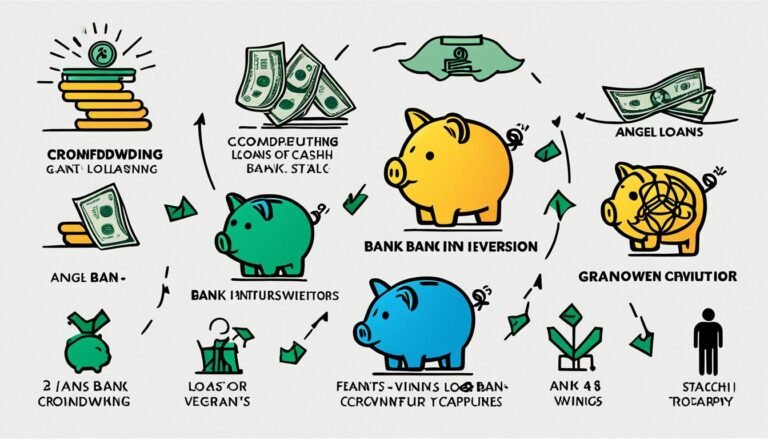Slash Costs with Reducing Living Expenses Tips
Are you looking for practical ways to reduce your living expenses and save money? Taking control of your finances is essential to achieving your financial goals, including paying off debt and building a secure future. By implementing cost-cutting strategies and budgeting tips, you can make significant progress towards reducing your expenses and improving your financial well-being.
Key Takeaways:
- Tracking your spending habits is the first step towards identifying areas where adjustments can be made.
- Creating a budget helps you prioritize your financial goals and allocate funds accordingly.
- Canceling unnecessary or unused subscriptions can free up additional money each month.
- Lowering your electricity usage can significantly reduce your utility bills.
- Prioritizing sustainability not only helps you save money but also benefits the environment.
Start Tracking Your Spending Habits
The first step in cutting spending and taking control of your finances is to track where your money is going. By tracking your spending habits, you can identify areas where adjustments are needed and find opportunities to save on expenses.
There are two main ways to track your spending habits. The first method is to manually write down every expense you make over a period of 30 or 60 days. This involves keeping a record of each purchase, whether it’s a small daily expense or a larger monthly bill. This manual tracking allows you to see a detailed breakdown of your expenses and analyze where your money is being spent. It’s important not to overlook any expense, as even small purchases can add up over time.
The second method of tracking your spending habits is to use technology to monitor your debit or credit card statements. Online banking tools and budgeting apps make it easy to keep tabs on your expenses digitally. These tools categorize your expenses automatically, allowing you to see how much you’re spending on different categories such as groceries, dining out, or entertainment. This digital tracking provides a convenient way to visualize your spending patterns and identify areas where adjustments can be made.
Tracking your spending habits enables you to differentiate between needs and wants, helping you make informed decisions about where you can cut back on expenses. It allows you to see the bigger picture of your financial situation and make adjustments that align with your financial goals.
“By tracking your spending habits, you can identify areas where adjustments are needed and find opportunities to save on expenses.”
Tracking Spending Habits: Benefits and Tips
Here are some benefits of tracking your spending habits:
- Greater awareness of your financial situation
- Identification of unnecessary or excessive expenses
- Opportunity to make budget adjustments
- Ability to set realistic financial goals
To effectively track your spending habits, consider these tips:
- Set aside dedicated time each week or month to review your expenses.
- Be consistent and diligent in recording every expense.
- Categorize your expenses to gain a clearer understanding of your spending patterns.
- Use budgeting apps or online tools to automate the tracking process.
- Regularly analyze your spending habits to identify areas for improvement.
- Adjust your budget based on your spending patterns and financial goals.
By starting to track your spending habits today, you can take the first step towards a more financially secure future. Through careful monitoring and analysis, you’ll gain valuable insights that will enable you to make informed decisions, adjust your expenses, and ultimately achieve your financial goals.
| Benefits of Tracking Spending Habits | Tips for Effective Expense Tracking |
|---|---|
| Greater awareness of your financial situation | Set aside dedicated time each week or month to review your expenses. |
| Identification of unnecessary or excessive expenses | Be consistent and diligent in recording every expense. |
| Opportunity to make budget adjustments | Categorize your expenses to gain a clearer understanding of your spending patterns. |
| Ability to set realistic financial goals | Use budgeting apps or online tools to automate the tracking process. |
Get on a Budget
Creating a budget is a crucial step in managing your expenses and achieving your financial goals. By carefully planning your income and expenses, you can allocate your resources effectively and stay on track towards becoming debt-free. Prioritizing your debt-free goal will provide motivation and keep you focused on your financial journey.
There are various tools and resources available to help you create a budget that suits your needs. Consider using budgeting apps, templates, or spreadsheets to track your income and expenses. These tools can provide a visual representation of your financial picture and help you make informed decisions.
Steps to Create a Budget
- Determine your income: Calculate your total income from all sources.
- List fixed monthly bills: Include expenses such as rent, utilities, and insurance.
- Identify needs vs. wants: Differentiate between essential expenses and discretionary spending.
- Allocate funds towards financial goals: Dedicate a portion of your income to paying off debt and saving.
- Set small goals: Break down your long-term financial goals into achievable milestones to maintain motivation.
Once you have created your budget, it is important to regularly monitor and adjust your spending habits. Review your budget periodically to ensure that you are staying on track and making progress towards your debt-free goal.
“A budget is telling your money where to go instead of wondering where it went.” – Dave Ramsey
| Budget Category | Allocated Amount |
|---|---|
| Fixed Monthly Bills | $1,200 |
| Discretionary Spending | $500 |
| Debt Repayment | $300 |
| Savings | $200 |
Creating a budget is an empowering step towards taking control of your finances. It allows you to make informed decisions about your spending, prioritize your financial goals, and ultimately become debt-free.
Cancel Unnecessary or Unused Subscriptions
In today’s digital age, it’s common for individuals to have a variety of monthly subscriptions. However, many of these subscriptions go unused or become unnecessary over time. Canceling these subscriptions can be a simple and effective way to reduce expenses and free up some extra money in your budget.
When evaluating your subscriptions, take a moment to consider how much value you are truly getting from each one. Are you actively using the products or services provided? Do they contribute to your daily life or enhance your leisure activities? If not, it may be time to say goodbye to that subscription.
Additionally, consider unsubscribing from newsletters and advertisements that clutter your inbox. This not only helps declutter your digital space but also reduces the chances of impulse purchases driven by enticing marketing. By cutting back on unnecessary subscriptions and digital distractions, you can regain control over your finances.
Benefits of Canceling Subscriptions:
- Reduced expenses: Canceling unused subscriptions can save you a significant amount of money each month.
- Financial clarity: By evaluating and eliminating unnecessary expenses, you gain a clearer view of your financial situation.
- Budget optimization: With fewer subscriptions draining your budget, you can allocate those funds towards other financial goals or essential expenses.
- Simpler financial management: Fewer subscriptions mean fewer bills to keep track of and manage, making it easier to stay organized.
It’s important to overcome the temptation of keeping subscriptions that are not worth the cost. Focus on prioritizing the subscriptions that align with your needs and values, and consider alternative free or more affordable options that provide similar value.
Remember, canceling unnecessary or unused subscriptions is a proactive step towards reducing expenses and taking control of your financial well-being.
Key Takeaways:
– Evaluate your subscriptions and determine which ones are no longer necessary.
– Unsubscribe from newsletters and advertisements that clutter your inbox.
– Allocate the money saved from canceled subscriptions towards more valuable expenses.
– Stay mindful of the value and cost of each subscription.
Reduce Electricity Use
Electricity costs can add up quickly and significantly impact your monthly expenses. By taking simple steps to reduce electricity use, you can lower your utility bills and save money in the long run. Implementing these energy-saving practices not only helps your wallet but also contributes to a more sustainable lifestyle. Here are some effective strategies to reduce electricity consumption:
- Turn off lights when not in use: Remember to switch off lights in empty rooms to avoid unnecessary energy consumption.
- Run appliances with full loads: Maximize the efficiency of your dishwasher and washing machine by waiting until they are full before running a cycle.
- Hang clothes to dry: Instead of relying on a dryer, try hanging your clothes outdoors or indoors on a drying rack. This method saves energy and preserves the quality of your garments.
- Adjust thermostat settings: Set your thermostat to an appropriate temperature to minimize the use of heating and cooling systems. Lowering the temperature during winter months and raising it during summer can significantly reduce energy consumption.
Shopping around for utility providers offering lower rates is another effective way to save money on your electricity bills. Compare the rates and plans offered by different providers in your area to find the most cost-effective option. Consider switching to renewable energy sources, such as solar power, if it is available and financially feasible.
Reducing your electricity use not only helps you lower utility bills but also contributes to a more sustainable future. By adopting these energy-saving practices, you can make a positive impact on both your finances and the environment.
Prioritize Sustainability
Cutting expenses can also align with your sustainability goals. By making environment-friendly choices, you can not only reduce your expenses but also minimize your carbon footprint and contribute to a greener planet.
One way to prioritize sustainability is by embracing thrifty living guidelines. Instead of buying new items, consider shopping at thrift stores or purchasing second-hand goods. This approach not only helps you save money but also reduces the demand for new production, which has a significant environmental impact.
Another way to prioritize sustainability is by reevaluating your transportation choices. Utilizing public transportation or cycling instead of relying solely on private cars can save you money on gas, parking fees, and car payments. Additionally, it helps reduce air pollution and traffic congestion, making a positive impact on the environment.
When it comes to reducing your utility bills, opt for energy-efficient choices. Install energy-efficient light bulbs and appliances that consume less power while delivering the same performance. This will significantly lower your electricity usage and contribute to sustainable energy consumption.
Water conservation is another vital aspect of sustainable living. Practice water-saving habits such as taking shorter showers, fixing leaky faucets, and utilizing rainwater for plants. These small changes can make a big difference in reducing water wastage and ultimately lower your water bills.
By prioritizing sustainability, you can create a positive impact on both your wallet and the environment. The choices you make today can contribute to a more sustainable future for generations to come.
Quotes:
“Sustainable living is not only about reducing waste and conserving resources. It’s also about making conscious choices that benefit both our finances and the environment.” – Anonymous
“Every small sustainable choice we make adds up to make a big difference. Let’s prioritize sustainability and create a greener future.” – Unknown
Lower Your Housing Expenses
Housing expenses often account for a significant portion of your budget. Whether you’re a renter or a homeowner, there are several strategies you can employ to reduce your housing costs and free up more money for other financial goals. Consider the following options:
1. Get a Roommate or Downsize
If you’re a renter, one effective way to lower housing expenses is by getting a roommate. Splitting the rent with someone can significantly reduce your monthly payments. Alternatively, you could downsize to a smaller and more affordable apartment. Analyze your needs and explore different living arrangements that can help you save money on rent.
2. Refinance or Remove Private Mortgage Insurance
For homeowners, refinancing your mortgage can be a smart move to lower your interest rates and potentially reduce your monthly payments. It’s worth exploring the current market conditions and considering refinancing as a means of reducing your housing costs. Additionally, if you’ve reached 20% equity in your home, you may be eligible to remove private mortgage insurance (PMI), which can further lower your expenses.
3. Rent Out a Portion of Your Home
If you own a home with extra space, you can generate additional income by renting out a portion of it. Whether it’s a spare room, a basement, or an accessory dwelling unit, such as a mother-in-law suite, renting out part of your home can help offset your housing expenses and potentially turn your property into a source of income.
4. Consider Renting Instead of Owning
In some cases, transitioning from homeownership to renting can be a viable solution for reducing housing costs. Selling your home, particularly if you’re in an expensive market or have significant maintenance expenses, and opting to rent instead can provide more flexibility and potentially save you money in the long run.
When exploring these strategies, it’s essential to carefully weigh the pros and cons and consider your specific circumstances. Each option carries its own set of advantages and considerations, so it’s crucial to evaluate them in terms of your financial goals and overall well-being.
5. Comparison Table: Housing Expense Reduction Strategies
| Housing Expense Reduction Strategy | Key Benefits | Considerations |
|---|---|---|
| Getting a Roommate | – Splitting rent reduces monthly payments. – Shared living expenses can lead to significant savings. |
– Compatibility with roommate. – Adjustment to shared living space. |
| Refinancing or Removing PMI | – Lower interest rates reduce mortgage payments. – Removing PMI eliminates an additional expense. |
– Closing costs. – Eligibility requirements for PMI removal. |
| Renting Out a Portion of Your Home | – Generates additional income. – Offsets housing expenses. – Potential tax advantages. |
– Tenant management. – Legal obligations as a landlord. |
| Transitioning from Owning to Renting | – Eliminates property maintenance expenses. – Provides more financial flexibility. |
– Market rental rates. – Emotional attachment to homeownership. |
By exploring these housing expense reduction strategies and finding the approach that aligns with your financial goals, you can effectively reduce your housing costs and achieve greater financial stability.
Consolidate Your Debt and Lower Interest Rates
Consolidating your debt can be a smart strategy to reduce your expenses and gain control over your financial situation. By combining multiple debts into one monthly payment, you can simplify your repayment process and achieve lower interest rates.
Debt consolidation offers several benefits. First, it allows you to lower your overall interest rate, which can significantly reduce the amount of money you pay towards interest every month. With lower interest rates, you can allocate more of your monthly payment towards paying off the principal debt, helping you become debt-free faster.
There are two common methods of debt consolidation: a debt consolidation loan and a debt management plan.
A debt consolidation loan involves taking out a new loan to pay off all your existing debts. This loan typically comes with a lower interest rate, making it easier to manage your payments and save money in the long run. With a single monthly payment, you’ll have a clear view of your debt repayment progress.
Alternatively, a debt management plan (DMP) involves working with a credit counseling agency to negotiate lower interest rates with your creditors. Under a DMP, you’ll make one consolidated payment to the credit counseling agency, which will then distribute the funds to your creditors on your behalf. This option is particularly beneficial if you’re struggling to make minimum payments or are dealing with high-interest credit card debt.
Regardless of the method you choose, debt consolidation can provide the financial relief you need to pay off debt and regain control of your finances. Remember to carefully evaluate your options, compare interest rates, and consider any potential fees or charges before deciding on the best approach for your situation.
The Benefits of Debt Consolidation
- Lower overall interest rates
- Simplified debt repayment with a single monthly payment
- Ability to become debt-free faster
- Improved financial management and budgeting
“Debt consolidation is a powerful tool that can help individuals lower their interest rates and pay off debt more efficiently.” – Financial Expert
Shop for Cheaper Insurance
When it comes to reducing expenses, one area that often gets overlooked is insurance. Taking the time to review your insurance policies and shop around for cheaper rates can lead to significant cost savings. Whether it’s homeowners or renters insurance, auto insurance, or health insurance, there are several strategies you can implement to lower insurance costs without compromising coverage.
Raise Deductibles
One way to lower your insurance premiums is by raising your deductibles. A deductible is the amount you have to pay out of pocket before your insurance coverage kicks in. By opting for a higher deductible, you can enjoy lower monthly premiums. However, keep in mind that you’ll need to have enough savings set aside to cover the higher deductible in case of a claim.
Bundle Policies
Another way to save on insurance costs is by bundling your policies. Many insurance companies offer discounts if you purchase multiple policies from them. For example, you can bundle your home and auto insurance or combine renters and liability insurance. Bundling not only helps you save money but also simplifies your insurance management by having all your policies with one provider.
Search for Competitive Rates
Don’t settle for the first insurance quote you receive. It’s essential to shop around and compare rates from different insurance companies. Take advantage of online comparison tools or work with an independent insurance agent who can provide you with multiple quotes. By doing your research, you can ensure that you’re getting the best possible deal on your insurance coverage.
| Insurance Type | Tips to Lower Costs |
|---|---|
| Homeowners or Renters Insurance | – Increase home security measures to qualify for discounts – Consider a higher deductible – Compare quotes from multiple insurers – Evaluate coverage limits to avoid overpaying |
| Auto Insurance | – Maintain a clean driving record – Bundle your auto insurance with other policies – Take advantage of available discounts – Consider reducing coverage for older vehicles |
| Health Insurance | – Compare plans and premiums during open enrollment – Consider a high-deductible plan paired with a health savings account – Utilize preventive care services to avoid future expenses – Review your coverage needs and make adjustments accordingly |
Shopping for cheaper insurance options can result in significant savings on your monthly expenses. By raising deductibles, bundling policies, and searching for competitive rates, you can reduce insurance costs while maintaining the protection you need.
Eat at Home
Dining out can be expensive, and cutting back on restaurant meals can lead to substantial savings. Meal planning and cooking at home allows you to take control of your food costs while also providing healthier options. By preparing meals in advance and shopping smartly, you can significantly reduce your grocery bill and make the most out of your budget.
Meal planning is a great way to streamline your cooking process and ensure you have everything you need on hand. It involves choosing recipes for the week, making a grocery list, and sticking to it when you go shopping. This approach eliminates the temptation to order takeout or dine out, as you already have everything you need to prepare delicious and cost-effective meals at home.
Additionally, it’s important to make the most of leftovers to avoid food waste and stretch your budget further. Make larger batches of meals and save the leftovers for future lunches or dinners. You can also get creative and repurpose leftovers into new dishes to keep your meals exciting and avoid monotony.
Another great way to save money on food expenses is by brown-bagging your lunch. Packing your own lunch not only helps you save on the cost of eating out but also allows you to have more control over the nutritional value of your meals. This practice can lead to significant savings over time.
Benefits of Eating at Home
There are several benefits to eating at home. Firstly, it gives you the opportunity to tailor your meals to your specific dietary requirements and preferences. You can choose healthier ingredients and control portion sizes, leading to better overall nutrition.
Secondly, cooking at home fosters a sense of creativity and experimentation in the kitchen. You can try out new recipes, techniques, and flavors, expanding your culinary skills and making mealtime more enjoyable.
Lastly, eating at home allows you to spend quality time with your family or loved ones. It offers an opportunity to bond over the cooking process and enjoy shared meals together, fostering stronger relationships and creating lasting memories.
“Cooking at home is a simple way to save money and take control of your food choices. It allows you to prioritize your health and well-being while also being mindful of your budget.”
By incorporating meal planning, utilizing leftovers, and packing your own lunches, you can significantly reduce your food expenses and take charge of your financial situation. Embrace the joy of cooking at home and reap the benefits of savings, improved nutrition, and quality time with loved ones.
Order Groceries Online and Use Coupons
Ordering groceries online is a convenient and efficient way to shop for your household needs. It not only saves you time and effort but also provides an opportunity to track your expenses and make budget-friendly choices. When shopping online, you have access to a wide range of products and can easily compare prices, ensuring you get the best value for your money.
One of the significant advantages of online grocery shopping is the ability to modify your cart based on the total cost. As you add items to your virtual cart, you can see the total amount and make adjustments accordingly. This helps you stay within your budget and avoid any impulsive purchases that can lead to unnecessary expenses.
To maximize your savings even further, make sure to utilize coupons when available. Many online grocery retailers offer digital coupons that can be applied at checkout, providing instant discounts on your selected items. These coupons can help you shave off a significant amount from your total bill, making your groceries even more budget-friendly.
Additionally, keep an eye on weekly ads and BOGO (buy one, get one) offers. These promotions can help you save money on essential items and stock up on groceries at discounted prices. By combining online shopping with strategic coupon usage and taking advantage of special promotions, you can significantly reduce your grocery expenses without compromising on the quality of the items you purchase.
Ordering groceries online and using coupons not only helps you save money but also provides a convenient and seamless shopping experience. Take advantage of the digital resources available to track your expenses, compare prices, and find the best deals. Make the most out of online grocery shopping by incorporating smart budgeting strategies and coupon usage to enjoy budget-friendly groceries delivered right to your doorstep.
Conclusion
Reducing expenses and saving money are essential components of effective financial management. By implementing a range of strategies, you can take control of your money and work towards achieving your financial goals. Start by tracking your spending habits to identify areas where adjustments can be made. Creating a budget will help allocate your resources wisely and prioritize your financial objectives, such as paying off debt.
Canceling unnecessary subscriptions and making sustainable choices can further reduce your living expenses. Lowering housing costs, consolidating debt, shopping for cheaper insurance options, and embracing home-cooked meals are additional strategies to consider. By incorporating online grocery shopping and utilizing coupons, you can maximize your savings on essential items.
Remember, reducing expenses is not about depriving yourself but about making smart choices with your money. It requires discipline and a willingness to make small changes that add up over time. By applying these reducing living expenses tips, you can achieve greater financial stability and improve your overall financial management.







